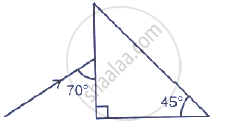Advertisements
Advertisements
प्रश्न
The diagram alongside shows the refraction of a ray of light from air to a liquid.
- Write the values of (i) angle of incidence, (ii) angle of refraction.
- Use Snell’s law to find the refractive index of liquid with respect to air.

उत्तर
(a) (i) Angle of incidence is the angle which the incident ray makes with normal.
∠i = 90° - 30° = 60°
(ii) The angle that the refracted beam creates with the normal is known as the angle of refraction.
∠r = 90° - 45° = 45°
(b) liquid's refractive index in relation to air.
μ Liquid = `sin i/sin r`
= `(sin 60°)/(sin 45°)`
= `(sqrt3/2)/(1/sqrt2)`
= `sqrt3/2 xx sqrt2`
= `(sqrt3 xx sqrt2)/(sqrt2 xx sqrt2)`
= `sqrt(3/2)`
APPEARS IN
संबंधित प्रश्न
Explain how spectrum is formed.
How does the angle of minimum deviation produces by a prism change with increase in :
the refracting angle of prism?
Complete Fig. 4.32 to show the path of the ray of single colour as it enters the prism and emerges out of it. Mark the angles wherever necessary.

A Water pond appears to be 2.7 m deep. If the refractive index of water is 4/3, find the actual depth of the pond.
A postage stamp kept below a rectangular glass block of refractive index 1.5 when viewed from vertically above it, appears to be raised by 7.0 mm. Calculate the thickness of the glass slab.
A fish swimming in a pond seems nearer than it really is. Explain.
Write a relation between the angle of incidence (i), angle of emergence (e), angle of the prism (A), and angle of deviation (d) for a ray of light passing through an equilateral prism.
What do you understand by the deviation produced by a prism?
How does the angle of deviation produced by a prism depend on the angle of incidence of light at the prism surface? Draw a graph to illustrate your answer.
The velocity of light in diamond is 121000 kms-1. What is its refractive index?
